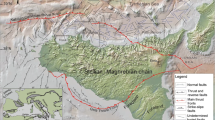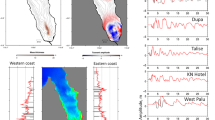Abstract
Submarine landslides occurring along the margins of the Gulf of Mexico (GOM) represent a low-likelihood, but potentially damaging source of tsunamis. New multibeam bathymetry coverage reveals that mass wasting is pervasive along the Yucatán Shelf edge with several large composite landslides possibly removing as much as 70 km3 of the Cenozoic sedimentary section in a single event. Using GIS-based analysis, the dimensions of six landslides from the central and northern sections of the Yucatán Shelf/Campeche Escarpment were determined and used as input for preliminary tsunami generation and propagation models. Tsunami modeling is performed to compare the propagation characteristics and distribution of maximum amplitudes throughout the GOM among the different landslide scenarios. Various factors such as landslide geometry, location along the Yucatán Shelf/Campeche Escarpment, and refraction during propagation result in significant variations in the affected part of the Mexican and US Gulf Coasts. In all cases, however, tsunami amplitudes are greatest along the northern Yucatán Peninsula.









Similar content being viewed by others
References
Adatte, T., Stinnesbeck, W., & Keller, G. (1996). Lithostratigraphic and mineralogic correlations of near K/T boundary clastic sediments in northeastern Mexico: Implications for origin and nature of deposition. In G. Ryder, D. Fastovsky, S. Gartner (Eds.), The Cretaceous–Tertiary event and other catastrophes in earth history: Boulder, Colorado, Geological Society of America Special Paper 307, 211–226.
Amante, C., & Eakins, B.W. (2009). ETOPO1 1 arc-minute global relief model: Procedures, data sources and analysis. NOAA Technical Memorandum NESDIS NGDC-24. National Geophysical Data Center, NOAA. doi:10.7289/V5C8276M.
Bourgeois, J. T., Hansen, A., Wiberg, P. L., & Kauffman, E. G. (1988). A tsunami deposit at the Cretaceous–Tertiary boundary in Texas. Science, 241, 567–570.
Bryant, W. R., Meyerhoff, A. A., Brown, N. K., Furrer, M., Pyle, T., & Antoine, J. W. (1969). Escarpments reef trends, and diapiric structures, eastern Gulf of Mexico. Bulletin American Association of Petroleum Geologists, 53, 2506–2542.
Chaytor, J. D., ten Brink, U. S., Solow, A. R., & Andrews, B. D. (2009). Size distribution of submarine landslides along the US Atlantic margin. Marine Geology, 264(1–2), 16–27.
Chaytor, J.D., Twichell, D.C., Lynett, P., & Geist, E.L. (2010). Distribution and tsunamigenic potential of submarine landslides in the Gulf of Mexico. In: D.C. Mosher, L. Moscardelli, R.C. Shipp, J.D. Chaytor, C.D. Baxter, H.J. Lee, & R. Urgeles (Eds.), Submarine mass movements and their consequences, advances in natural and technological hazards research (745–754), vol 28. Springer, Netherlands.
Dalle Valle, G., & Gamberi, F. (2011). Pockmarks and seafloor instability in the Olbia continental slope (northeastern Sardinian margin, Tyrrhenian Sea). Marine Geophysical Researches, 32, 193–205.
Denne, R. A., Scott, E. D., Eickhoff, D. P., Kaiser, J. S., Hill, R. J., & Spaw, J. M. (2013). Massive Cretaceous-Paleogene boundary deposit, deep-water Gulf of Mexico: New evidence for widespread Chicxulub-induced slope failure. Geology, 41, 983–986.
Ewing, M., Worzel, J. L., Beall, A. O., et al. (1969). Initial reports of the deep sea drilling project (Vol. 1). Washington D.C.: U.S. Government Printing Office.
Geist, E. L., Lynett, P. J., & Chaytor, J. D. (2009). Hydrodynamic modeling of tsunamis from the Currituck landslide. Marine Geology, 264, 41–52.
Horrillo, J., Wood, A., Kim, G. B., & Parambath, A. (2013). A simplified 3-D Navier Stokes numerical model for landslide-tsunami: Application to the Gulf of Mexico. Journal Geophysical Research, 118, 6934–6950.
Horrillo, J.J., Wood, A.L., Williams, C., Parambath, A., & Kim, G.-B. (2010). Construction of tsunami inundation maps in the Gulf of Mexico, Tech. Rep, National Tsunami Hazard Mitigation Program (NTHMP), National Weather Service Program Office, NOAA.
Lawton, T. F., Shipley, K. W., Aschoff, J. L., Giles, K. A., & Vega, F. J. (2005). Basinward transport of Chicxulub ejecta by tsunami-induced backflow, La Popa basin, northeastern Mexico, and its implications for distribution of impact-related deposits flanking the Gulf of Mexico. Geology, 33, 81–84.
Lindsay, J. F., Shipley, T. H., & Worzel, J. L. (1975). Role of canyons in the growth of the Campeche Escarpment. Geology, 3, 533–536.
Locker, S. D., & Buffler, R. T. (1983). Comparison of lower Cretaceous carbonate shelf margins, northern Campeche Escarpment and northern Florida Escarpment, Gulf of Mexico. American Association of Petroleum Geologists. Studies in Geology, 15, 123–128.
López-Venegas A.M., ten Brink U.S., Geist E.L (2008). Submarine landslide as the source for the October 11, 1918 Mona Passage tsunami: Observations and modeling. Marine Geology, 254(1), 35–46.
Lynett, P., & Liu, P. L. F. (2002). A numerical study of submarine landslide generated waves and runup. Proceedings of the Royal Society of London, Ser. A, 458, 2885–2910.
Lynett, P., & Liu, P. L. F. (2005). A numerical study of the run-up generated by three-dimensional landslides. Journal of Geophysical Research: Oceans, 110, C03006. doi:10.1029/2004JC002443.
Mulder, T. (2011). Gravity processes and deposits on continental slope, rise and abyssal plains. In H. Huneke & T. Mulder (Eds.), Deep-sea sediments (pp. 25–125). Amsterdam: Elsevier.
National Geophysical Data Center/World Data Service (NGDC/WDS): Global Historical Tsunami Database. National Geophysical Data Center, NOAA. doi:10.7289/V5PN93H7.
Pampell-Manis, A., Horrillo, J., Shigihara, Y., & Parambath, L. (2016). Probabilistic assessment of landslide tsunami hazard for the northern Gulf of Mexico. Journal of Geophysical Research Oceans. doi:10.1002/2015JC011261.
Parsons, T., Geist, E. L., Ryan, H. F., Lee, H. J., Haeussler, P. J., Lynett, P., et al. (2014). Source and progression of a submarine landslide and tsunami: The 1964 Great Alaska earthquake at Valdez. Journal Geophysical Research. doi:10.1002/2014JB011514.
Paull, C. K., Caress, D. W., Gwiazda, R., Urrutia-Fucugauchi, J., Rebolledo-Vieyra, M., Lundsten, E., et al. (2014). Cretaceous–Paleogene boundary exposed: Campeche Escarpment, Gulf of Mexico. Marine Geology, 357, 392–400.
Paull, C. K., Freeman-Lynde, R., Bralower, T. J., Gardemal, J. M., Neumann, A. C., D’Argenio, B., et al. (1990a). Geology of the strata exposed on the Florida Escarpment. Marine Geology, 91, 177–194.
Paull, C. K., Spiess, F. N., Curray, J. R., & Twichell, D. (1990b). Origin of Florida Canyon and the role of spring sapping on the formation of submarine box canyons. Geological Society of America Bulletin, 102, 502–515.
Shaw, C. E., & Benson, L. (2015). Possible tsunami deposits on the Caribbean coast of the Yucatán Peninsula. Journal of Coastal Research, 31, 1306–1316.
ten Brink, U. S., Geist, E. L., & Andrews, B. D. (2006). Size distribution of submarine landslides and its implication to tsunami hazard in Puerto Rico. Geophysical Research Letters, 33, L11307.
Twichell, D. C., Parson, L. M., & Paull, C. K. (1990). Variations in the styles of erosion along the Florida Escarpment, eastern Gulf of Mexico. Marine and Petroleum Geology, 7, 253–266.
Ward, S. N. (2001). Landslide tsunami. Journal of Geophysical Research: Solid Earth, 106(B6), 11201–11215.
Worzel, J.L., Bryant, W., Beall Jr., A.O., Capo, R., Dickinson, K., Foreman, H.P., Laury, R., McNeely, B.W., & Smith, L. (1970). Site 86 Initial Reports of the Deep Sea Drilling Project 10, Texas A & M University, Ocean Drilling Program, College Station, TX, United States, pp 25–47.
Acknowledgments
We would like to acknowledge the assistance of the Schmidt Ocean Institute, the captain and crew of the R/V Falkor, the David and Lucile Packard Foundation, Eve Lundsten, Krystle Anderson, and Brian Andrews. Nathan Miller, Uri ten Brink, David Tappin, and three anonymous reviewers provided helpful reviews which improved the manuscript. Any use of trade, product, or firm names is for descriptive purposes only and does not imply endorsement by the US Government.
Author information
Authors and Affiliations
Corresponding author
Rights and permissions
About this article
Cite this article
Chaytor, J.D., Geist, E.L., Paull, C.K. et al. Source Characterization and Tsunami Modeling of Submarine Landslides Along the Yucatán Shelf/Campeche Escarpment, Southern Gulf of Mexico. Pure Appl. Geophys. 173, 4101–4116 (2016). https://doi.org/10.1007/s00024-016-1363-3
Received:
Revised:
Accepted:
Published:
Issue Date:
DOI: https://doi.org/10.1007/s00024-016-1363-3




